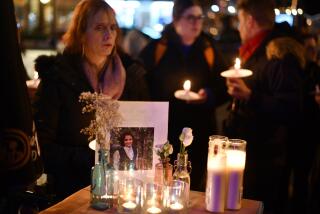THE NATION - News from July 12, 2009
- Share via
CHICAGO — The bullying seemed inescapable.
Iain Steele’s family and friends say it followed him from junior high to high school -- from hallways, where one tormentor shoved him into lockers, to cyberspace, where another posted a video on Facebook making fun of his taste for heavy metal music.
“At one point, [a bully] had told [Iain] he wished he would kill himself,” said Matt Sikora, Iain’s close friend.
Iain’s parents know their son had other problems, but they think the harassment contributed to a deepening depression that hospitalized the 15-year-old twice this year. On June 3, while his classmates were taking final exams, he went to the basement of his Western Springs, Ill., home and hanged himself with a belt.
His death stunned the quiet suburb west of Chicago and unleashed an outpouring of support for his parents, William and Liz, who say greater attention should be paid to bullying and its connection to mental health.
“No kid should be afraid for himself to go to school,” his father said. “It should be a safe environment where they can intellectually thrive. And he was, literally, just frightened to go to school, fearing what he would have to deal with on that day. And it was day after day.”
A school spokeswoman said she did not think Iain was bullied. Police are investigating the allegations.
Nearly 30% of American children are bullied or are bullies themselves, according to the National Youth Violence Prevention Resource Center. Bullying can be physical, verbal or psychological and is repetitive, intentional and creates a perceived imbalance of power, said Dr. Joseph Wright, senior vice president at Children’s National Medical Center in Washington.
This month, the American Academy of Pediatrics will include a section on bullying in its official policy statement on the pediatrician’s role in preventing youth violence.
Wright, a lead author of the statement, said the decision to address the issue was because of a growing body of research over the last decade linking bullying to youth violence, depression and suicidal thoughts.
Last year, the Yale School of Medicine conducted an analysis of the link between childhood bullying and suicide in 37 studies from 13 countries, finding that both bullies and their victims were at high risk of contemplating suicide.
Iain Steele enjoyed riding his skateboard, his father said, but after hip surgery in eighth grade limited his mobility, he picked up the guitar and impressed an instructor with his musical talent.
He was revered by younger children in the neighborhood, often fixing their skateboards, settling their disputes and including them in games. “He was a very gentle, kind kid, compassionate to a fault,” his father said.
But Iain’s embrace of heavy metal set him apart from classmates. He let his hair grow to shoulder length and wore mostly black clothing, including jeans with chains and T-shirts of heavy metal bands with dark, sometimes morbid lyrics.
For this, his junior high classmates often called him “emo” -- a slang term for angst-ridden followers of a style of punk music, said Sikora, 15.
The bullying could also be physical, Iain’s friends and parents said. In eighth grade, one bully pushed Iain into a locker while he was on crutches and accused him of faking an injury to get out of gym class. Iain rarely shied away from his tormentors, however, and in this case, he punched the bully in the jaw, his father said.
“He was mainly bullied only because he was different, or hurt, or stupid things like that,” Sikora said. “He never bothered anybody. . . . It was all just because he was different and an easy target.”
William Steele said he sat down with the principal at his son’s junior high and with a bully’s mother, but the harassment continued.
After graduating from junior high in 2008, Iain found new friends -- and new tormentors -- in high school. A bully emerged who at first acted friendly but then posted a homemade video on Facebook pretending to be Iain playing heavy metal on guitar.
“It was like a public humiliation” to Iain, Sikora said.
The family of the student did not respond to requests for a comment.
By this winter, Iain’s mental health had begun a downward spiral, his parents said. In February, he told them he was having suicidal thoughts and asked to be admitted to the hospital.
He stopped going to school and began attending an outpatient program, seeing a therapist and a psychiatrist and taking medication for depression and anxiety. He tried returning to school on a half-day basis, but soon became overwhelmed with makeup work and inquiries from classmates who heard rumors he had tried to kill himself. After a few days in school, Iain asked to be readmitted to the hospital, where he stayed for a week, his parents said.
As summer approached, he began showing signs of improvement. He was easier to communicate with, did his chores when asked, and his doctors thought they had found the right balance in his medication, his father said.
“He seemed to be in a calm, happy place,” he said.
Iain’s parents and friends say they do not know of any incidents that might have triggered what happened June 3, when his father found him in the basement. His death was ruled a suicide by hanging, according to the Cook County Medical Examiner’s Office. He did not leave a note.
Looking back, Iain’s parents wonder what factors besides bullying may have contributed to their son’s depression.
Iain’s favorite heavy metal bands, such as Lamb of God and Children of Bodem and Bullet for My Valentine, often have lyrics with dark messages. One Bullet for My Valentine song is about being bullied, and another song contains the refrain: “The only way out is to die.”
Also, Iain was deeply hurt this spring after a brief relationship with a girl he met in his outpatient program. The two exchanged text messages, but her parents and therapists advised against them dating and about two months ago barred her from having communication with him.
Still, Iain’s parents remain convinced that bullying played a significant role in their son’s depression. As Iain’s story spread through the community, many people approached Liz Steele to describe their own experiences with bullying, depression or suicide, she said.
“A lot of people don’t want to talk about mental health or bullying because it’s a difficult thing to talk about, but we need to talk about it,” she said. “It shouldn’t be a stigma.”
Meanwhile, the community has rallied behind the Steeles. In Iain’s memory, his classmates tied white ribbons around hundreds of trees in the neighborhood. On June 10, about 500 people attended a memorial service.
Friends have established several Facebook groups in his memory, including the Iain Steele Remembrance Group, which has more than 700 members. The commentary on the group’s wall was summed up by a high school student who said she did not know Iain but had learned from his death.
“I’m learning to treat everyone with respect, even people who I don’t know well or people who I might not get along with,” she wrote. “If there is anything good that can come out of this tragedy, the responsibility lies with us to live with kindness and be aware that life is fragile.”
--
More to Read
Sign up for Essential California
The most important California stories and recommendations in your inbox every morning.
You may occasionally receive promotional content from the Los Angeles Times.













